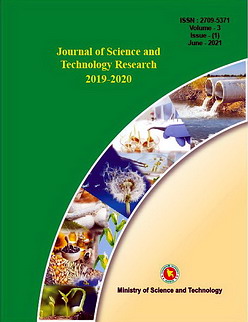Chemical Synthesis of Cytosine β-D-Riboside Esters for Pathogenicity, Anticancer and Computational Studies
DOI:
https://doi.org/10.3329/jscitr.v3i1.62804Keywords:
Synthesis; Cytosine β-D-Riboside; Spectroscopy; Anticancer; ComputationalAbstract
The growing importance of nucleoside derivatives as unique potential antimicrobial and therapeutic agents has drawn attention to the synthesis of thymidine derivatives. In the present study, cytidine (i.e., cytosine β-D-riboside) was treated with various acyl halides to produce 5ʹ-O-acyl cytidine derivatives by direct acylation method with an excellent yield. To obtain newer derivatives for antimicrobial assessment studies, the 5ʹ-O-cytidine derivatives were further modified into three series of 2′,3′-di-O-acyl cytidine derivatives (schemes 1 and 2) containing a wide variety of functionalities in a single molecular framework. The chemical structures of the newly synthesized derivatives were elucidated by analyzing their physicochemical, elemental, and spectroscopic data. The antimicrobial tests demonstrated that most of the derivatives exhibited significant antibacterial and antifungal activities in vitro. The derivatives 7, 10, and 11 were the most potent derivatives against Pseudomonas aeruginosa, Salmonella abony, and Staphylococcus strains, with the minimum inhibitory concentration ranging from 0.16 ± 0.01 to 1.25 ± 0.03 mg/mL and minimum bactericidal concentration ranging from 0.32 ± 0.01 to 2.5 ± 0.06 mg/mL. The strongest inhibitory activity was observed against Gram-negative bacteria. Some of the derivatives had a strong antifungal activity. The structure–activity relationship (SAR) and X-ray powder diffraction of these acylated products were also studied. In addition, derivative 6 exhibited good anticancer activity against EAC cells. Quantum chemical studies were performed employing density functional theory with B3LYP/3-21G level. To support this observation, molecular docking studies have been performed against HIV-1 reverse transcriptase (RT) (PDB: 3V4I). Most of the molecules studied out here could bind near the crucial catalytic binding site, Tyr181, Ile94, Ile382, Lys374, Val381, Val90, and Tyr34 of the HIV-1 reverse transcriptase (RT), and the molecules were surrounded by other active site residues like Gln332, Trp406, Asn265, Gly93, His96, Pro95, and Thr165. The absorption, distribution, metabolism, excretion, and toxicity properties predicted the improved pharmacokinetic properties of all derivatives.
J. of Sci. and Tech. Res. 3(1): 23-40, 2021
126
172
Downloads
Published
How to Cite
Issue
Section
License
Copyright (c) 2021 SMA Kawsar, J Ferdous

This work is licensed under a Creative Commons Attribution 4.0 International License.




